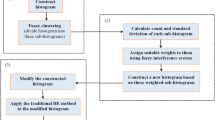Abstract
In this work, an algorithm for Contrast Enhancement is proposed using Gaussian Mixture Models to identify groups of pixels in an image corresponding to different objects, and an automatic function for generating a Fuzzy Logic Inference System. The system relates the input values of the original image to output values for a new image so that each group is processed according to their properties. The input and output fuzzy sets are created using a proposed function based on the clustering results. The optimal number of groups for the segmentation of the image is found using statistical metrics. The results were compared with the original images and the images processed using histogram equalization, considering the standard deviation as a metric for contrast. The output images presented an increment in the contrast without increasing the noise.
Access this chapter
Tax calculation will be finalised at checkout
Purchases are for personal use only
Similar content being viewed by others
References
Bishop, C.M.: Pattern Recognition and Machine Learning (Information Science and Statistics). Springer, Berlin, Heidelberg (2006)
Bora, D.J.: Importance of image enhancement techniques in color image segmentation: a comprehensive and comparative study. CoRR abs/1708.05081 (2017)
Cheng, H., Xu, H.: A novel fuzzy logic approach to contrast enhancement. Pattern Recogn. 33(5), 809–819 (2000). http://www.sciencedirect.com/science/article/pii/S0031320399000965
Christ, M.C.J., Parvathi, R.M.S.: Fuzzy c-means algorithm for medical image segmentation. In: 2011 3rd International Conference on Electronics Computer Technology, vol. 4, pp. 33–36 (April 2011)
Costin, H.: A fuzzy rules-based segmentation method for medical images analysis. Int. J. Comput. Commun. Control 8(2), 196 (2013). https://doi.org/10.15837/ijccc.2013.2.301
Dash, L., Chatterji, B.: Adaptive contrast enhancement and de-enhancement. Pattern Recogn. 24(4), 289–302 (1991). http://www.sciencedirect.com/science/article/pii/003132039190072D
Gonzalez, R.C., Woods, R.E.: Digital Image Processing, 3rd edn. Prentice-Hall Inc., Upper Saddle River (2006)
James, G., Witten, D., Hastie, T., Tibshirani, R.: An Introduction to Statistical Learning. Springer, New York (2013). https://doi.org/10.1007/978-1-4614-7138-7
Jang, C.Y., Kang, S.J., Kim, Y.H.: Adaptive contrast enhancement using edge-based lighting condition estimation. Digital Sig. Process. 58, 1–9 (2016). http://www.sciencedirect.com/science/article/pii/S1051200416300240
Jones, E., Oliphant, T., Peterson, P., et al.: SciPy: open source scientific tools for Python (2001). http://www.scipy.org/. Accessed Nov 2017
Lai, Y.R., Chung, K.L., Lin, G.Y., Chen, C.H.: Gaussian mixture modeling of histograms for contrast enhancement. Expert Syst. Appl. 39(8), 6720–6728 (2012). https://doi.org/10.1016/j.eswa.2011.12.018. As References [11] and [12] are same, we have deleted the duplicate reference and renumbered accordingly. Please check and confirm
Lin, P.T., Lin, B.R.: Fuzzy automatic contrast enhancement based on fuzzy c-means clustering in CIELAB color space. In: 2016 12th IEEE/ASME International Conference on Mechatronic and Embedded Systems and Applications (MESA), pp. 1–10 (August 2016)
Parihar, A.S., Verma, O.P., Khanna, C.: Fuzzy-contextual contrast enhancement. IEEE Trans. Image Process. 26(4), 1810–1819 (2017)
Posada, D., Buckley, T.R., Thorne, J.: Model selection and model averaging in phylogenetics: advantages of Akaike information criterion and Bayesian approaches over likelihood ratio tests. Syst. Biol. 53(5), 793–808 (2004). https://doi.org/10.1080/10635150490522304
Russell, S., Norvig, P.: Artificial Intelligence: A Modern Approach, 3rd edn. Prentice Hall Press, Upper Saddle River (2009)
Fatima, S., Shubhangi, D., Fatima, H.: Image contrast enhancement using Gaussian mixture modeling and its comparison with different algorithms. Int. J. Adv. Eng. Technol. Manag. Appl. Sci. 3 (2016)
Shakeri, M., Dezfoulian, M., Khotanlou, H., Barati, A., Masoumi, Y.: Image contrast enhancement using fuzzy clustering with adaptive cluster parameter and sub-histogram equalization. Digital Sig. Process. 62, 224–237 (2017). http://www.sciencedirect.com/science/article/pii/S1051200416301828
Shang, Z., Lin, Z., Wen, G., Yao, N., Zhang, C., Zhang, Q.: Aerial image clustering analysis based on genetic fuzzy c-means algorithm and gabor-gist descriptor. In: 2014 11th International Conference on Fuzzy Systems and Knowledge Discovery (FSKD), pp. 77–81 (August 2014)
Vikram, B.R., Bhanu, M.A., Venkateswarlu, S.C., Babu, M.R.: Adaptive neuro fuzzy for image segmentation and edge detection. In: Proceedings of the International Conference and Workshop on Emerging Trends in Technology, ICWET 2010, pp. 315–319. ACM, New York (2010). https://doi.org/10.1145/1741906.1741976
van der Walt, S., Colbert, S.C., Varoquaux, G.: The numpy array: a structure for efficient numerical computation. Comput. Sci. Eng. 13(2), 22–30 (2011)
Warner, J., et al.: JDWarner/scikit-fuzzy: scikit-fuzzy 0.3.1 (October 2017)
Yelmanova, E.S., Romanyshyn, Y.M.: Medical image contrast enhancement based on histogram. In: 2017 IEEE 37th International Conference on Electronics and Nanotechnology (ELNANO), pp. 273–278 (April 2017)
Author information
Authors and Affiliations
Corresponding author
Editor information
Editors and Affiliations
Rights and permissions
Copyright information
© 2018 Springer Nature Switzerland AG
About this paper
Cite this paper
Solórzano-Espíndola, C.E., Anzueto-Ríos, Á. (2018). Automatic Fuzzy Contrast Enhancement Using Gaussian Mixture Models Clustering. In: Mata-Rivera, M., Zagal-Flores, R. (eds) Telematics and Computing . WITCOM 2018. Communications in Computer and Information Science, vol 944. Springer, Cham. https://doi.org/10.1007/978-3-030-03763-5_11
Download citation
DOI: https://doi.org/10.1007/978-3-030-03763-5_11
Published:
Publisher Name: Springer, Cham
Print ISBN: 978-3-030-03762-8
Online ISBN: 978-3-030-03763-5
eBook Packages: Computer ScienceComputer Science (R0)




